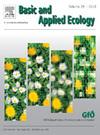Evolutionary Agroecology: Individual fitness, population yield and resource availability in wheat
IF 3.5
2区 环境科学与生态学
Q2 ECOLOGY
引用次数: 0
Abstract
Evolutionary Agroecology theory predicts that the relationship between population yield and individual fitness among genotypes of a crop species is unimodal, and experimental evidence supports this. We test the theory further by investigating the role of resource availability on this relationship by comparing growth and reproductive output of three old and three modern cultivars of wheat (Triticum aestivum) in mixture and monocultures grown at three resource levels. The relationship between population grain yield and individual fitness (mean individual grain yield in mixture) of genotypes was resource dependent in a way that is consistent with the theory: when resource levels are low and limit individual growth directly, individual and population yield are positively correlated. When resource levels are high and the growth of individual plants is limited by competition for these resources, the relationship between individual fitness and population yield becomes negative. There was evidence for the unimodal relationship at the intermediate resource level. Old cultivars had higher fitness than newer cultivars at all three resource levels. Old cultivars had higher yields at low resource levels, but the newer cultivars yielded more when resource levels were high. Evaluating individual fitness and population yield in different environments may help wheat breeders to develop locally adapted, cooperative cultivars to increase production across large wheat-producing areas.
进化农业生态学:小麦的个体适应性、群体产量和资源可用性
农业生态进化理论预测,作物物种基因型的群体产量和个体适应性之间的关系是单峰的,实验证据也支持这一预测。我们通过比较小麦(Triticum aestivum)的三个古老栽培品种和三个现代栽培品种在三种资源水平下的混合栽培和单一栽培中的生长和生殖产量,研究了资源可用性对这种关系的作用,从而进一步验证了这一理论。基因型的群体谷物产量和个体适应性(混合物中的平均个体谷物产量)之间的关系与资源相关,这与理论相符:当资源水平较低并直接限制个体生长时,个体产量和群体产量呈正相关。当资源水平较高,单株植物的生长受到资源竞争的限制时,个体适应性与群体产量之间的关系就会变为负相关。有证据表明,在中间资源水平上存在单模关系。在所有三个资源水平上,老栽培品种的适应性都高于新栽培品种。在资源水平较低时,老品种的产量较高,但在资源水平较高时,新品种的产量较高。评估不同环境下的个体适应性和群体产量可能有助于小麦育种者培育出适应当地情况的合作栽培品种,以提高大面积小麦产区的产量。
本文章由计算机程序翻译,如有差异,请以英文原文为准。
求助全文
约1分钟内获得全文
求助全文
来源期刊

Basic and Applied Ecology
环境科学-生态学
CiteScore
6.90
自引率
5.30%
发文量
103
审稿时长
10.6 weeks
期刊介绍:
Basic and Applied Ecology provides a forum in which significant advances and ideas can be rapidly communicated to a wide audience. Basic and Applied Ecology publishes original contributions, perspectives and reviews from all areas of basic and applied ecology. Ecologists from all countries are invited to publish ecological research of international interest in its pages. There is no bias with regard to taxon or geographical area.
 求助内容:
求助内容: 应助结果提醒方式:
应助结果提醒方式:


